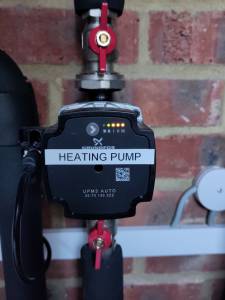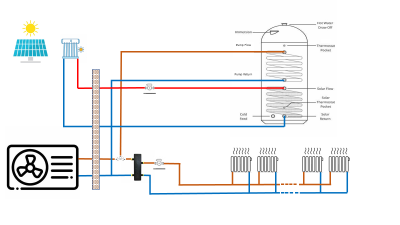Secondary circulation pump settings
I have a secondary circulation pump on the other side of my Low Loss Header from my heat pump. I realise there is a lot to discuss about the problems around an LLH but for now I am interested in the setting of the pumps and therefore how they might be interacting.
The pump in question is a Grundfos UPM3 AUTO 25-70 130 zzz, I've included a picture below which shows the setting of the pump. It is not speed controlled by the heat pump and appears to be on all the time except when the heat pump is doing DHW.
Given the pump inside the heat pump is variable speed I can't see how having a fixed speed pump on a high setting will do anything other than cause a lot of mixing in the LLH and so might help partially explain the low COP values I get (currently 1.8 - 2.4).
The heat pump is a 16kW Midea monobloc. From the manuals for similar pumps there seem to be setting options for Proportional Pressure, Constant Pressure, and Constant Curve but I don't know which of these would work best in my setup (diagram below).
Any thoughts greatly appreciated.
16kW Midea Monobloc R32 Heat Pump (Heating & DHW)
4kW Solar PV (No battery storage yet)
CPC 12 INOX Solar Thermal (DHW)
Posted by: @alan-mGiven the pump inside the heat pump is variable speed I can't see how having a fixed speed pump on a high setting will do anything other than cause a lot of mixing in the LLH and so might help partially explain the low COP values I get (currently 1.8 - 2.4).
Your concern about mixing flow and return temperatures within the LLH is an issue for efficiency. And this is very likely to be more extreme if flow rates are in any way different either side of the low loss header. The mixing of the hotter LWT with the RWT means that the HP is having to work harder to produce the correct deltaT only for it to be mixed and cooled again before the water gets to the emitters.
if you have some means of measuring pipe temps entering and leaving the LLH you will know straight away if you have a significant heat mixing/loss problem.
However if you have a heat pump that has an internal circulation pump built in then this may be more complicated to do anything about it especially if it is a variable speed pump and you’re secondary pump is manually controlled and especially if operating at a fixed full speed setting.
Our situation is different to yours in that our Ecodan has an external Primary circulation pump which is now set to a constant pressure on the slowest speed which gives us a flow rate of 13 litres per minute. (Well within manufacturers minimum required flow rate) the hp then modulates to produce the deltaT of about 5 to 7c. Again this might be different to how your Midea HP regulates it’s heat output.
We have then adjusted our secondary pump to the same pump speed and checked flow rates again to try and match the flows through both circuits. This has meant that the temperature loss through the header has been measured to be only 1c. Not ideal but it’s much better than it was.
Im not sure how you might do something similar if you have a variable pump speed from an internal pump.... unless you can get a second output cable from controller to try to match the pump speeds but then you would need a compatible pump.
The other option, as I think you were hinting at, would be to explore the possibility of removing the low loss header but only if your system can operate as a single circuit.
i hope this helps clarify what can be done and perhaps someone who knows Midia might have an easier fix solution.
Our COP figures were significantly improved from 1.59 to a promising 3.3 to 3.7 depending on outside ambients. We still have the LLH fitted at the moment.
- 26 Forums
- 2,367 Topics
- 53.7 K Posts
- 203 Online
- 6,042 Members
Join Us!
Worth Watching
Latest Posts
-

RE: Solis S6-EH1P8K-L-PLUS – Why I Chose It and What I’ve Learned So Far
Interesting question. To be frank, since I have no inte...
By Majordennisbloodnok , 3 hours ago
-
RE: Changing from 4-port buffer to volumizer
@andy1618 see the very sage advice from @editor above. ...
By JamesPa , 13 hours ago
-
RE: New Fogstar 15.5kWh upright solution
The video shows the JK balancer, but the connection of ...
By Batpred , 15 hours ago
-
RE: Ecodan unable to hit legionella target temp - what's the consensus?
@9jwr9 Hi, yes this is the issue with every (stand alon...
By ASHP-BOBBA , 17 hours ago
-
RE: Help me keep the faith with my air source heat pump installation
@adamk FWIW I managed unintentionally to 'coax' mine in...
By JamesPa , 17 hours ago
-
RE: Help needed with Grant Aerona 3 issues
Ok please post back once experiment complete. Give it ...
By JamesPa , 17 hours ago
-
RE: Octopus Cosy Heat Pump Owners & Discussion Thread
You are in essence right. Adia only works with selecte...
By JamesPa , 18 hours ago
-

No, you haven’t missed out, @batpred. This thread’ll st...
By Majordennisbloodnok , 19 hours ago
-

RE: Tesla Powerwall – More of a ‘Luxury’ Than an ROI Winner!
Also, though they weren’t prepared to match the price t...
By Toodles , 20 hours ago
-
RE: How long will your energy contract last?
My INTELLI-FIX-12M-25-08-29 has less than 12 months to ...
By Batpred , 20 hours ago
-

RE: GivEnergy 2025 forthcoming batteries and inverters
Then, perhaps @toodles , you should've made a submissio...
By Transparent , 20 hours ago
-
RE: Balancing financial efficiency and comfort using the Octopus Cosy tariff
I am wondering if anyone with an EV could find the 7p/k...
By Batpred , 20 hours ago
-
Possibly, but it would also reduce DeltaT across the em...
By JamesPa , 20 hours ago
-

RE: ASHP sizing - value of Heat Transfer Coefficient
@cathoderay It was reminiscent of the BBC Open Universi...
By Toodles , 21 hours ago
-
-

@morgan They are unsupervised these days, can’t get the...
By Toodles , 4 days ago
-

RE: Setback savings - fact or fiction?
Exactly. We only need to compare conditions, to decide ...
By cathodeRay , 5 days ago
-
RE: Need Help Optimising My Rushed ECO4 Install: 12kW Bosch Heat Pump
Welcome @mickamills We too have an oversized 12kW Sa...
By Old_Scientist , 5 days ago
-
RE: My Powerwall 3 Consumes 3-4 kWh/Day in Self-Consumption: Is This Normal?
@caron I can confirm that the power usage of the PW3 is...
By Old_Scientist , 5 days ago





